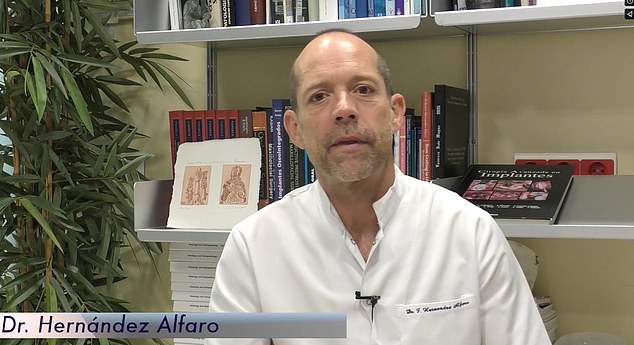Young Americans are flying across the ocean to get the jawline of their dreams, surgeons have revealed.
Dr. Frederico Alfaro, who runs the Barcelona Maxillofacial Institute, says that about half of his patients are international, with Americans being the main foreign client.
“In fact, my second case this morning is a patient from New York,” he told DailyMail.com. “We get a lot of American patients.”
The clinic posts many of its patients’ transformations online, which is likely to help attract foreign patients looking to transform their jaws, and about 50 percent of patients seek the procedure for cosmetic purposes, the doctor said.
For surgery, doctors cut and reposition the mandible (lower jaw) and then fix it in a new position using titanium plates and screws. They may also cut bones in the midface and chin to reposition them.
Once a patient’s case is accepted, they can join the clinic’s international package, where they book international flights and spend at least a week in Spain. The surgery itself typically lasts only an hour and a half, while the remaining days allow people to recover.
Speaking of his patients, Dr Alfaro said: ‘One of the main concerns is the lack of facial projection, the lack of definition of the jaw line and neck. A lack of virility, we could put it that way.

The above shows one of the clinic’s patients, Gustavo, before and after undergoing surgery to change the shape of his jaw and maxilla, the bone in the middle of the face that supports the upper teeth. He also underwent surgery to improve the shape of his chin.
At his clinic, Dr. Alfaro said he receives around 200 patients a year, at least half of whom are international clients.
But Dr. Alfaro said that in all cases his team takes a “holistic approach” and will take steps to ensure the client likes the results, even if a given procedure is not strictly medically necessary.
Surgeries such as repositioning the jaw can cost between $17,000 and $19,000 in the United States, while those to reposition the maxilla (the bone in the middle of the face that supports the teeth) can cost around $7,000.
Patients can have a primary consultation over the phone and will be asked to send photographs and medical notes about their situation before surgery is accepted.
Many of the clinics’ patients have medical problems, such as malocclusion (misalignment of the upper and lower teeth) and sleep apnea, which can be caused by bones constricting the airways.
The clinic also offers cosmetic procedures including face lifts, cheek augmentation and blepharoplasty, or surgery to reduce the amount of skin over the eyes.
Among the clinic’s most viewed transformations on its social media is Gustavo, an 18-year-old from northern Spain, who says the surgery left him feeling “much more confident.”

In the photo above appears Dr. Frederico Hernández Alfaro, who is behind the clinic that offers the surgeries.
He was referred to the clinic for Class II malocclusion in 2020, where the upper teeth significantly overlap the lower teeth, causing chewing problems.
Upon admission, a questionnaire also revealed that he had significant concerns about his appearance and also suffered from mild sleep apnea.
Dr. Alfaro said, “In Gustavo’s case, he had all these problems, but his main concern was facial aesthetics, and I have to say that probably 50 percent of my patients’ main concerns are facial aesthetics.”
During surgery, doctors first performed a bilateral sagittal split osteotomy, where the lower jaw bone is cut and repositioned further forward to align the teeth. It can then be secured with titanium plates and screws.
He then underwent a Le Fort I osteotomy, where horizontal cuts are made in the upper jaw, which is then moved downward to widen the airway, solving sleep problems. It may also have been secured with titanium plates and screws.
And finally, doctors performed an advancement and descent mentoplasty, or chin advancement, surgically repositioning the chin bone to improve its shape, position and projection.
Dr. Alfaro said that as part of the surgery at his clinic, they can also inject fat grafts into the cheeks and lips to further improve patients’ appearance and ensure they are happy with the results.
There is swelling and bruising after surgery, which can take up to four weeks to go away.
Many patients resume normal activities once the swelling is reduced, although it may take about six months for the bones to fully heal.
Gustavo told DailyMail.com that the post-surgery results “felt amazing” and “I couldn’t believe what I saw in the mirror.”
He said: ‘Even now, when I look at a photograph I took the night before the operation to compare the results… I still can’t believe it was me.
‘As I’ve gained more confidence in myself, things have gotten better. The truth is that before the operation I didn’t even try to talk to a girl, thinking I wouldn’t get anywhere.’


